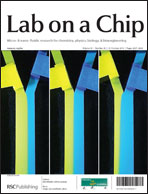Passive self-synchronized two-droplet generation†
Abstract
We describe the use of two passive components to achieve controllable and alternating droplet generation in a microfluidic device. The approach overcomes the problems associated with irregularities in


 Please wait while we load your content...
Please wait while we load your content...